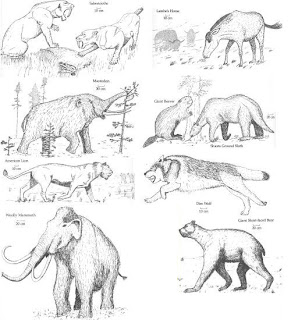An article in the recent issue of Science magazine details findings at the
Buttermilk Creek archaeological sites in Texas and discusses migration routes of Early Americans into North America. Findings at these Texas sites argue for pre-Clovis Early Americans in North America as early as 15,500 years ago.
During the last ice-age sea level was some 400 feet lower than it is today. The lower sea level exposed a land mass, Beringia, that stretched between Siberia and Alaska and was as much as 1000 miles wide. Most scientists think that Early Americans arrived in North and South America via this route.
The “Clovis-first” proponents believe that Early Americas arrived in the present lower 48 states of North America between 12,800 and 13,100 years ago. Another group of archaeologists believe that Early Americans crossed through Beringia earlier, as early as 40,000 years ago.
There were two general paths of migrations from Siberia into the lower parts of North America. If people were in the southern part of North America prior to about 15,000 years ago, they probably arrived by boat following the Pacific coast. Prior to that the continental ice sheet covered most of present day Canada and joined with the Cordilleran ice sheet that covered the Rocky Mountains out to the Pacific coast. The only migration route available at the time was the coastal route. The ancestors of the people who lived along Buttermilk Creek probably followed this route.
Image credit: Dixon, E. James (2000)
15,000 years ago the ice sheets began to retreat and, in the process, opened up an ice-free corridor along the eastern side of the Rocky Mountains. The “Clovis-first” proponents favor Early Americans arriving in the southern part of the continent via the ice-free corridor route.
Image credit: Dixon, E. James (2000)
Another theory, favored by Dennis Stanford of the Smithsonian Institution and Bruce Bradley of the University of Exeter, suggests that the Early Americans came to North America from Spain, following the edge of the North Atlantic ice cap. Stanford and Bradley’s main argument is that the Clovis points in the Americas appear very similar to the Solutrean points found in southern Europe (see figure below). Also, currently, the preponderance of Clovis sites appear to be located in the eastern US. Stanford and Bradley suggest that ice-age fisherman and hunters sailed to America in small boats made of animal skins about 18,000 years ago; similar to the boats used by Eskimos today to hunt whales and seals.

Evidence suggesting Clovis-age people used the ice-free corridor has been found in Alberta and British Columbia. Some evidence has also been found along the Pacific coast supporting the coastal route theory. However, there may be even more evidence that is now under water. Any possible evidence for the migration route from Europe would now be at the bottom of the Atlantic Ocean.
There is good evidence of an Early American settlement at Monte Verde, Chile that date back to at least 12,500 years ago and possibly as much as 14,800 years ago. As additional study is being made, evidence supporting earlier arrivals of people into North and South America is increasing. Migrations from Siberia likely happened more than once and each may have followed different migration routes. However, studies of current native North Americans, focusing on language, dental structure, and genetics, pretty well demonstrate that their ancestors came to the Americas via Siberia. So far the evidence for European origins is lacking.
References:
Waters, Michael R., et. al. (2011) “The Buttermilk Creek Complex and the Origins of Clovis at the Debra L. Friedkin Site, Texas”; Science 25 March 2011: Vol. 331 no. 6024 pp. 1599-1603
Dixon, E. James (2000) "Bones Boats & Bison; Archeology and the First Colonization of Western North America"; The University of New Mexico Press; 322p.
Mithen, Steven, (2003) “After the Ice”; Harvard University Press; 622 p.







